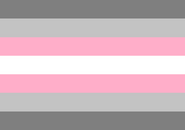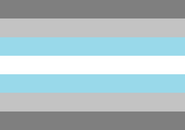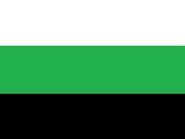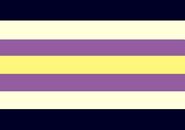mNo edit summary Tags: Visual edit apiedit |
(Undo revision 19769 by Slushymang (talk)) Tag: apiedit |
||
| Line 1: | Line 1: | ||
| − | '''Pride flags''' are often used at pride parades and other visibility events to show identification as, or support for, a particular [[gender identity]]. They may also be combined with [[gender symbols]]. Read on to learn about the different flags in the trans, nonbinary, |
+ | '''Pride flags''' are often used at pride parades and other visibility events to show identification as, or support for, a particular [[gender identity]]. They may also be combined with [[gender symbols]]. Read on to learn about the different flags in the trans, nonbinary, and genderqueer community. |
| + | |||
| + | ==[[Transgender]] Flag== |
||
| + | [[File:Trans_Pride_Flag.png|thumb|The transgender pride flag by Monica Helms]] |
||
The current transgender flag was designed by trans woman Monica Helms in 1999. It has five stripes in total, from top to bottom: blue, pink, white, pink, blue. It first appeared a pride parade in Phoenix, Arizona in 2000. [http://www.transflag.com][http://actup.org/news/usa-transgender-pride-flag-raised-for-the-first-time-in-the-castro/] |
The current transgender flag was designed by trans woman Monica Helms in 1999. It has five stripes in total, from top to bottom: blue, pink, white, pink, blue. It first appeared a pride parade in Phoenix, Arizona in 2000. [http://www.transflag.com][http://actup.org/news/usa-transgender-pride-flag-raised-for-the-first-time-in-the-castro/] |
||
Revision as of 08:42, 3 July 2016
Pride flags are often used at pride parades and other visibility events to show identification as, or support for, a particular gender identity. They may also be combined with gender symbols. Read on to learn about the different flags in the trans, nonbinary, and genderqueer community.
Transgender Flag
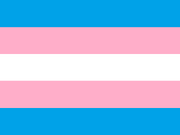
The transgender pride flag by Monica Helms
The current transgender flag was designed by trans woman Monica Helms in 1999. It has five stripes in total, from top to bottom: blue, pink, white, pink, blue. It first appeared a pride parade in Phoenix, Arizona in 2000. [1][2]
- The blue stripes represent men as blue is the traditional color for baby boys.
- The pink stripes represent women as pink is the traditional color for baby girls.
- The white represents those who don't neatly fit into the gender binary and intersex people, as well as representing the crossover between genders that many trans people feel they undergo in transitioning.
Nonbinary Flag
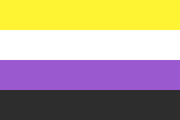
The nonbinary pride flag designed by Kye Rowan.
The nonbinary pride flag was created by 17 year old Kye Rowan in February of 2014 when a call was put out by several members of their community for a flag that could represent nonbinary folk who did not feel that the genderqueer flag represented them. This flag was intended to go alongside Marilyn Roxie's genderqueer flag rather than replace it. [3][4][5]
The flag consists of four stripes coloured (from top to bottom) yellow, white, purple and black.
- Yellow represents those whose gender exists outside of and without reference to the binary as yellow is often used to distinguish something as its own.
- White represents those who have many or all genders as white is the photological presence of color and/or light.
- The purple stripe represents those who feel their gender is between or a mix of female and male as purple is the mix of traditional boy and girl colors. The purple also could be seen as representing the fluidity and uniqueness of nonbinary people.
- The final black stripe represents those who feel they are without gender, as black is the photological absence of color and/or light.
Genderqueer Flag
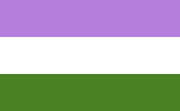
Genderqueer flag designed by Marilyn Roxie.
The final version of Marilyn Roxie's genderqueer pride flag was created in June 2011. It underwent two other versions with the same color scheme in 2010. It originally attempted to represent all non-binary and genderqueer people, however, as the genderqueer community grew the flag became synonymous with "genderqueer", thus leaving many non-binary people feeling forced under a label they didn't want. Rather than try to replace Roxie's flag, another flag has come to sit along side it to represent those who wanted it. [6]
The genderqueer flag has three stripes coloured (from top to bottom) purple, white and green.
- Chartreuse green represents those outside the gender binary as it is the inverse color to purple, the combination of pink and blue.
- The white stripe represents agenderness and gender neutrality.
- The third stripe is purple, to represent those whose genders are of, between, or a mix of female and male.
Intersex Flag
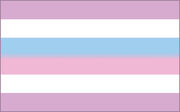
Intersex flag by Natalie Phox
An intersex flag was created in 2009 by Natalie Phox. It consists of five horizontal stripes coloured (from top to bottom) lavender, white, a double-width stripe with a gradient from blue to pink, white and lavender. The gradient represents the range of sexes between male and female, and the lavender represents a combination of male and female traits.
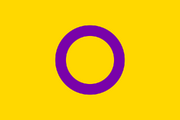
Intersex flag designed by Organisation Intersex International Australia.
An alternate intersex flag was created in 2013 by Organisation Intersex International Australia. It features a yellow background with a purple ring in the centre. It was designed to be unique and non-derivative, and to avoid colours associated with traditional gender roles such as blue and pink. The unbroken circle symbolises wholeness and completeness, and the right for intersex people to be who and how they want to be. [7]
Genderfluid Flag
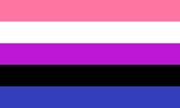
Genderfluid Flag by JJ Poole.
Created in 2012 by JJ Poole (genderfluidity). It has five horizontal stripes which are coloured (top to bottom) pink, white, purple, black and blue. [8]
- Pink for femininity.
- Blue for masculinity.
- Purple for both femininity and masculinity.
- Black for the lack of gender.
- White for all genders.
Agender Flag
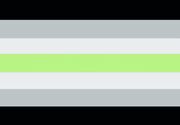
Agender Flag by transrants (finalized version)
Created 2014 by transrants. It has seven horizontal stripes which are coloured (top to bottom) black, grey, white, green, white, grey, black. [9]
- Both black and white represent the complete absense of gender.
- Grey represents being semi-genderless.
- Green represents nonbinary gender, because it is the inverse of purple.
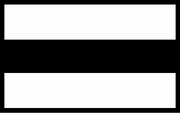
Agender flag by Rumpus Parable
Created 2014 by Rumpus Parable. Simple and clean lined agender flag design.
- Black is to indicate a distinct identity in those without gender. The color black for agender persons is chosen for its correspondence with black being the total absence of color in the light spectrum.
- White acknowledges the historical use as an all-inclusive color for anyone who is non-binary in sex and/or gender and the identity color of black to be placed against to indicate its specific grouping within that traditionally generalized non-binary color.
The two colors have been used alone to intentionally be agender specific without the addition of others usually seen to give reference to gendered identities of any type and aesthetically to create a stark, bold, and simple contrast for the emphasis in the difference and separation from genders expressed and included in other pride flags.
Pangender Flag
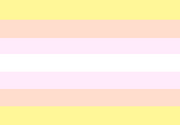
Pangender pride flag proposed by pangendering.
Created 2015 by pangendering. This based on the agender flag. It consists of seven stripes coloured (top to bottom) yellow, pink, violet-pink, white, violet-pink, pink, yellow. The colors are very bright so that they represent the multiplicity of genders (because the white light, in the electromagnetic spectrum, is a combination of all colors).
- Yellow represents all the genders that are not related to female and male.
- Light red represents the transition to the genders which are related to female and male.
- Light violet-pink represents the combination of female and male.
- White represents the blend of all these genders.
IngenDer Flag

Just white. Might be changed to add globe.
As IngenDerism is about the unity of humanity, rather than separating people by their differences, a white flag is used, as all colours are merely part of white.
Other Gender Pride Flags
There are, of course, many other official and proposed pride flags for specific identities throughout the community. Below is a look through a few of them:
